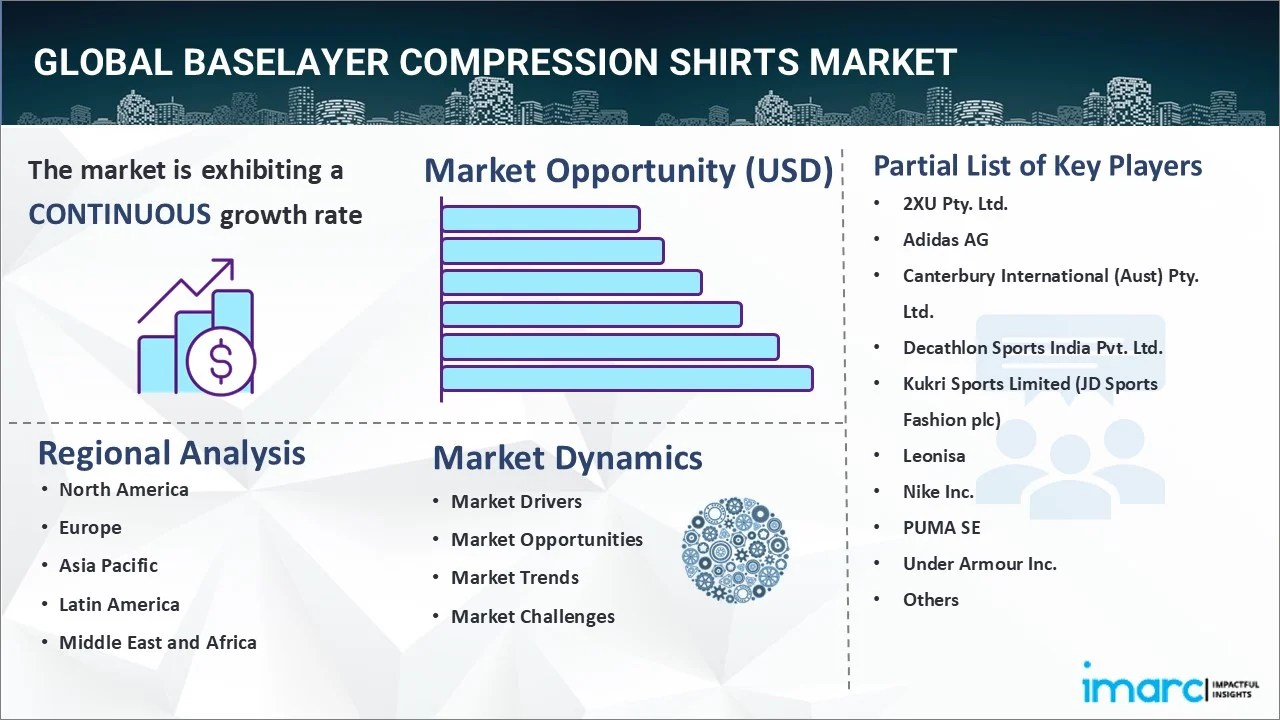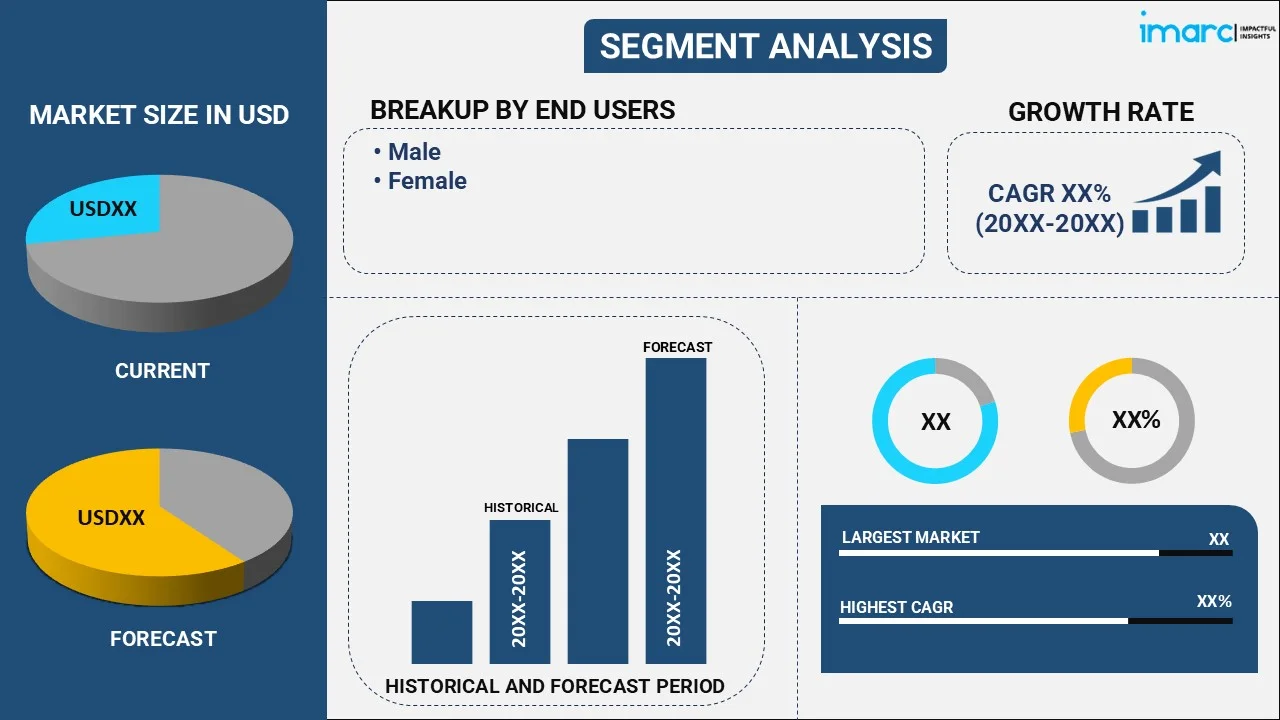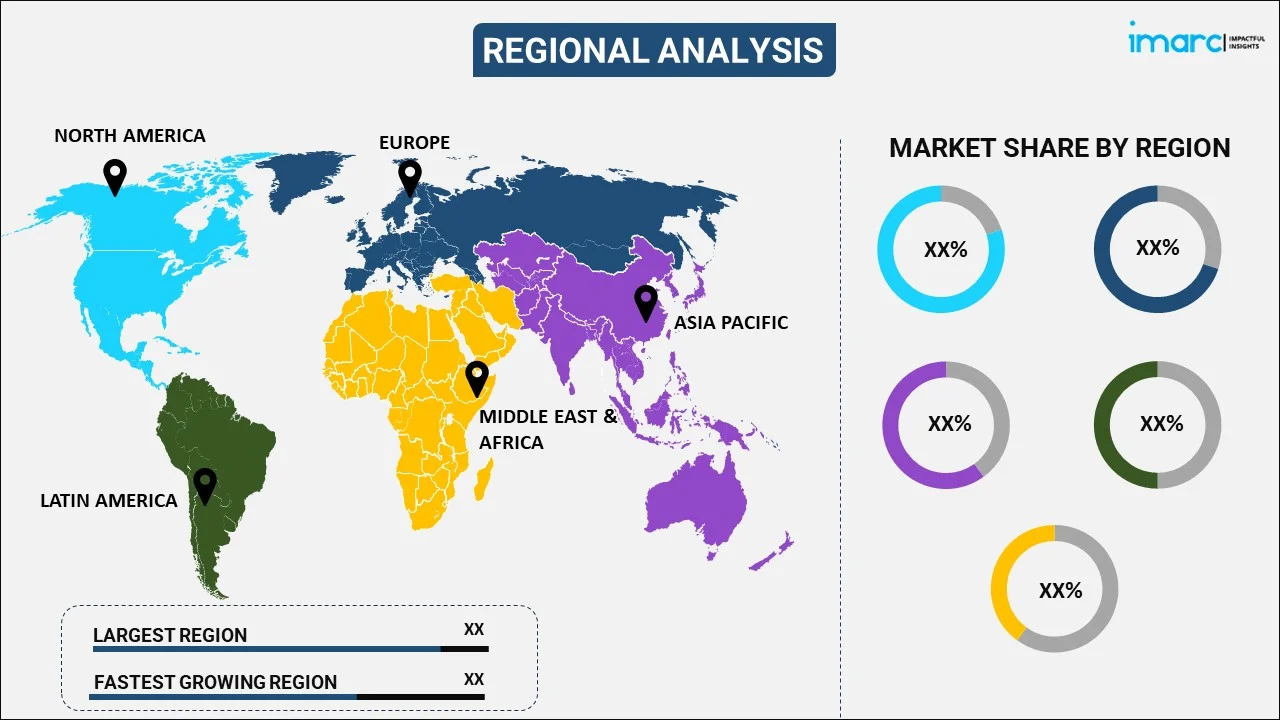
Baselayer Compression Shirts Market Report by End User (Male, Female), Distribution Channel (Hypermarket and Supermarket, Specialty Store, Online, and Others), and Region 2025-2033
Market Overview:
The global baselayer compression shirts market size reached USD 480.3 Million in 2024. Looking forward, IMARC Group expects the market to reach USD 720.5 Million by 2033, exhibiting a growth rate (CAGR) of 4.61% during 2025-2033. The increasing awareness of compression wear benefits, thriving fitness and sports industry, continuous advancements in fabric technology, the trend of athleisure wear, the convenience of e-commerce channels, endorsements by professional athletes and teams, rising disposable incomes, and sustainability-focused product innovations are boosting the market growth.
|
Report Attribute
|
Key Statistics
|
|---|---|
|
Base Year
|
2024
|
|
Forecast Years
|
2025-2033
|
|
Historical Years
|
2019-2024
|
| Market Size in 2024 | USD 480.3 Million |
| Market Forecast in 2033 | USD 720.5 Million |
| Market Growth Rate 2025-2033 | 4.61% |
A baselayer compression shirt is a specialized type of athletic apparel designed to enhance performance, provide support, and offer comfort during physical activities. It is typically constructed from a blend of synthetic materials such as polyester and elastane and is manufactured using advanced weaving and knitting techniques that result in a tight, stretchy fit. This snug fit helps in the compression aspect, as it exerts gentle pressure on the muscles, improving blood circulation and reducing muscle vibration. Baselayer compression shirts are primarily used by athletes and fitness enthusiasts during various sports and workouts, as they offer several benefits, such as they wick moisture away from the body, keeping the wearer dry and preventing discomfort caused by sweat. Additionally, the compression aspect provides muscle stabilization, reducing the risk of injury and enhancing endurance. There are different types of baselayer compression shirts, ranging from short-sleeved to long-sleeved, and varying in compression levels from mild to firm.

The global baselayer compression shirts market is influenced by a multitude of drivers, such as the increasing awareness of the benefits of compression wear in enhancing athletic performance and reducing muscle fatigue. Additionally, the growing fitness and sports industry, coupled with the rising health consciousness among consumers, has led to a surge in demand for baselayer compression shirts, which is boosting the market growth. Moreover, advancements in fabric technology, such as moisture-wicking and temperature regulation properties, have contributed to the market's expansion. Furthermore, the trend of athleisure wear has further boosted the adoption of compression shirts in casual settings, which is propelling the market growth. In line with this, the expanding e-commerce sector and easy accessibility of these products online have also driven the market growth. Athletes and fitness enthusiasts are increasingly opting for compression wear as part of their routine attire. Additionally, endorsements by professional athletes and sports teams, the rise in disposable income, and escalating demand for premium compression shirts are facilitating the market growth.
Baselayer Compression Shirts Market Trends/Drivers:
Increasing awareness of compression wear benefits
The first driver shaping the global baselayer compression shirts market is the increasing awareness of the benefits associated with wearing compression garments. As more individuals engage in various physical activities, there is a growing realization of how compression shirts can positively impact performance and recovery. Compression wear is designed to reduce targeted pressure on specific muscle groups, aiding in improved blood circulation and reducing muscle fatigue. This heightened awareness is primarily due to a wealth of scientific studies and endorsements by athletes, which have emphasized the advantages of compression clothing. Consumers now understand that wearing baselayer compression shirts can enhance their workout sessions, reduce the risk of injuries, and expedite post-exercise recovery. This knowledge has driven a surge in demand for compression shirts, making them a staple in the fitness and sports industry.
Growing fitness and sports industry
The second influential driver in the global baselayer compression shirts market is the thriving fitness and sports industry. With an increasing number of individuals participating in sports and fitness activities, the demand for performance-enhancing apparel like compression shirts has skyrocketed. Athletes, whether amateur or professional, seek every advantage to excel in their respective disciplines, and compression wear has become an integral part of their attire. Furthermore, the rise in health consciousness among people of all ages has further propelled the market. As individuals prioritize their well-being and fitness goals, they turn to compression shirts not only for their performance benefits but also for the comfort and support they provide during workouts.
Advancements in fabric technology
The third driver steering the global baselayer compression shirts market is the continuous advancements in fabric technology. Manufacturers have been at the forefront of innovation, developing materials with superior properties to meet the evolving needs of consumers. Moisture-wicking fabrics, for instance, are designed to keep athletes dry by efficiently removing sweat from the skin's surface. Temperature-regulating materials help maintain optimal body temperature during exercise, enhancing overall comfort. These technological advancements in fabric design and manufacturing have not only improved the functionality of compression shirts but also increased their appeal. Consumers today expect more from their activewear, and compression shirts with cutting-edge fabric technologies have risen to meet these expectations.
Baselayer Compression Shirts Industry Segmentation:
IMARC Group provides an analysis of the key trends in each segment of the market, along with forecasts at the global, regional, and country levels for 2025-2033. Our report has categorized the market based on end user and distribution channel.
Breakup by End User:

- Male
- Female
Male represents the leading market segment
The report has provided a detailed breakup and analysis of the market based on the end user. This includes male and female. According to the report, male represented the largest segment.
The male segment of the baselayer compression shirts market is primarily influenced by several key factors, such as the increasing awareness among men regarding the performance-enhancing benefits of compression wear. Men, like their female counterparts, are recognizing how compression shirts can improve blood circulation, reduce muscle fatigue, and enhance their athletic performance during workouts and sports activities. Additionally, the growing emphasis on fitness and a desire for a well-toned physique have led to a surge in demand for compression shirts among men. The male demographic also values the durability and versatility of compression shirts, which can be worn not only for sports but also as casual athleisure wear. Furthermore, endorsements by male athletes and fitness influencers resonate with this segment, reinforcing the credibility and desirability of compression shirts. The male-oriented product designs, including masculine colors and styles, also play a pivotal role in driving the male segment's growth.
Breakup by Distribution Channel:
- Hypermarket and Supermarket
- Specialty Store
- Online
- Others
Specialty Store accounts for the majority of the market share
A detailed breakup and analysis of the market based on the distribution channel has also been provided in the report. This includes hypermarket and supermarket, specialty store, online, and others. According to the report, specialty store represented the largest segment.
The specialty store segment in the baselayer compression shirts market is propelled by the easy product availability in specialty stores. It benefits from a niche focus on compression wear, offering a curated selection of high-quality products tailored to meet the specific needs and preferences of consumers seeking performance-enhancing apparel. This specialization allows for a deeper understanding of customer requirements and the ability to provide personalized guidance, thereby enhancing the shopping experience. Additionally, the expertise and knowledge of staff in specialty stores play a pivotal role in educating customers about the benefits of compression shirts and helping them make informed choices. Furthermore, the exclusivity and brand reputation associated with specialty stores attract loyal customers who prioritize premium products and value the in-store experience. These factors, combined with a commitment to stocking the latest innovations in compression wear, position specialty stores as a significant driver in the market, catering to a discerning consumer base.
Breakup by Region:

- North America
- United States
- Canada
- Asia Pacific
- China
- Japan
- India
- South Korea
- Australia
- Indonesia
- Others
- Europe
- Germany
- France
- United Kingdom
- Italy
- Spain
- Others
- Latin America
- Brazil
- Mexico
- Others
- Middle East and Africa
North America leads the market, accounting for the largest baselayer compression shirts market share
The market research report has also provided a comprehensive analysis of all the major regional markets, which include North America (the United States and Canada); Europe (Germany, France, the United Kingdom, Italy, Spain, and others); Asia Pacific (China, Japan, India, South Korea, Australia, Indonesia, and others); Latin America (Brazil, Mexico, and others); and the Middle East and Africa. According to the report, North America accounted for the largest market share.
Several key factors are driving the North American baselayer compression shirts market, including the region's strong emphasis on fitness and sports activities, which has led to a heightened demand for performance-enhancing apparel. Athletes and fitness enthusiasts in North America prioritize high-quality compression shirts to optimize their workouts and aid in muscle recovery. In line with this, the widespread awareness of the health benefits associated with compression wear has significantly contributed to market growth. Consumers understand that compression shirts can reduce muscle fatigue, improve blood circulation, and enhance overall comfort during physical activities. Additionally, the influence of prominent sports leagues, athletes, and teams in North America has created a culture of endorsement, reinforcing the popularity of compression shirts. Furthermore, the e-commerce infrastructure in the region makes it convenient for consumers to access a wide range of compression wear products, further boosting market growth.
Competitive Landscape:
A comprehensive competitive analysis of the baselayer compression shirts market reveals a dynamic landscape characterized by various players vying for market share. Companies in this sector compete based on several key factors. Product innovation is paramount, as firms strive to develop compression shirts with cutting-edge features such as moisture-wicking, temperature regulation, and sustainability-focused materials. Pricing strategies play a crucial role, with some companies targeting premium markets by offering high-quality, premium-priced products, while others focus on affordability to cater to a broader consumer base. Distribution channels also shape competition, with e-commerce platforms offering convenience and global reach. Brand reputation and endorsements by athletes or sports teams can sway consumer preferences. Quality control and manufacturing standards are vital, ensuring that products meet customer expectations for comfort and performance. Moreover, effective marketing and promotional strategies are essential to create brand awareness and customer loyalty.
The market research report has provided a comprehensive analysis of the competitive landscape. Detailed profiles of all major companies have also been provided. Some of the key players in the market include:
- 2XU Pty. Ltd.
- Adidas AG
- Canterbury International (Aust) Pty. Ltd.
- Decathlon Sports India Pvt. Ltd.
- Kukri Sports Limited (JD Sports Fashion plc)
- Leonisa
- Nike Inc.
- PUMA SE
- Under Armour Inc.
- Zensah
(Please note that this is only a partial list of the key players, and the complete list is provided in the report.)
Baselayer Compression Shirts Market Report Scope:
| Report Features | Details |
|---|---|
| Base Year of the Analysis | 2024 |
| Historical Period | 2019-2024 |
| Forecast Period | 2025-2033 |
| Units | Million USD |
| Scope of the Report | Exploration of Historical and Forecast Trends, Industry Catalysts and Challenges, Segment-Wise Historical and Predictive Market Assessment:
|
| End Users Covered | Male, Female |
| Distribution Channels Covered | Hypermarket and Supermarket, Specialty Store, Online, Others |
| Regions Covered | Asia Pacific, Europe, North America, Latin America, Middle East and Africa |
| Countries Covered | United States, Canada, Germany, France, United Kingdom, Italy, Spain, China, Japan, India, South Korea, Australia, Indonesia, Brazil, Mexico |
| Companies Covered | 2XU Pty. Ltd., Adidas AG, Canterbury International (Aust) Pty. Ltd., Decathlon Sports India Pvt. Ltd., Kukri Sports Limited (JD Sports Fashion plc), Leonisa, Nike Inc., PUMA SE, Under Armour Inc., Zensah, etc. |
| Customization Scope | 10% Free Customization |
| Post-Sale Analyst Support | 10-12 Weeks |
| Delivery Format | PDF and Excel through Email (We can also provide the editable version of the report in PPT/Word format on special request) |
Key Questions Answered in This Report:
- How has the global baselayer compression shirts market performed so far, and how will it perform in the coming years?
- What are the drivers, restraints, and opportunities in the global baselayer compression shirts market?
- What is the impact of each driver, restraint, and opportunity on the global baselayer compression shirts market?
- What are the key regional markets?
- Which countries represent the most attractive baselayer compression shirts market?
- What is the breakup of the market based on the end user?
- Which is the most attractive end user in the baselayer compression shirts market?
- What is the breakup of the market based on the distribution channel?
- Which is the most attractive distribution channel in the baselayer compression shirts market?
- What is the competitive structure of the global baselayer compression shirts market?
- Who are the key players/companies in the global baselayer compression shirts market?
Key Benefits for Stakeholders:
- IMARC’s industry report offers a comprehensive quantitative analysis of various market segments, historical and current market trends, market forecasts, and dynamics of the baselayer compression shirts market from 2019-2033.
- The research report provides the latest information on the market drivers, challenges, and opportunities in the global baselayer compression shirts market.
- The study maps the leading, as well as the fastest-growing, regional markets. It further enables stakeholders to identify the key country-level markets within each region.
- Porter's five forces analysis assist stakeholders in assessing the impact of new entrants, competitive rivalry, supplier power, buyer power, and the threat of substitution. It helps stakeholders to analyze the level of competition within the baselayer compression shirts industry and its attractiveness.
- Competitive landscape allows stakeholders to understand their competitive environment and provides an insight into the current positions of key players in the market.
Need more help?
- Speak to our experienced analysts for insights on the current market scenarios.
- Include additional segments and countries to customize the report as per your requirement.
- Gain an unparalleled competitive advantage in your domain by understanding how to utilize the report and positively impacting your operations and revenue.
- For further assistance, please connect with our analysts.
 Request Customization
Request Customization
 Speak to an Analyst
Speak to an Analyst
 Request Brochure
Request Brochure
 Inquire Before Buying
Inquire Before Buying




.webp)




.webp)












